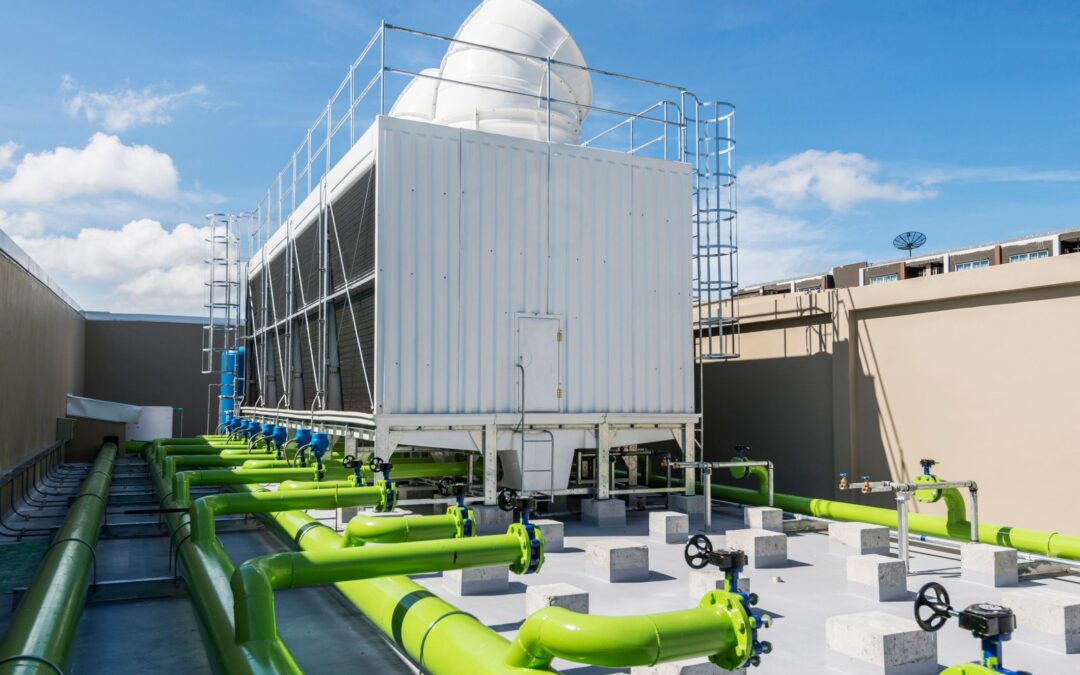As with most mechanical equipment, cooling towers require maintenance to remain operating at peak performance. A critical part of this maintenance is water treatment and passivation. So, what kind of water treatment do cooling towers need and what is passivation?
Cooling towers are an integral part of your building’s heat transfer and comfort-cooling system. Since the equipment deals with both water and heat exchange, proper water treatment and passivation are required in order to maintain efficiency. Treatments help minimize the risk of corrosion, scaling, and microbiological buildup, reducing the system’s productivity. These issues can also cause premature equipment problems, leading to earlier and pricier replacements.
Passivation, more specifically, refers to the process of slowly (and under controlled conditions) oxidizing zinc to provide a passive layer on the outer coating. This process provides better resistance to corrosion since most cooling towers are no longer naturally passivated. Ideally, pre-treatment should occur but a passivation program is a must come installation time, before the system receives cycled tower water.
What to avoid
Ultimately, what you’re trying to avoid is an increased cost. Whether that’s due to the increased energy needed because the system is not running efficiently or due to costly equipment repairs and replacements, water treatment addresses cooling tower problems like…
- Corrosion is an issue with any system where water and metal come into contact, it requires the maintenance of proper pH levels to control the process.
- The foam which can form and overflow the cooling tower sump or be blown out by the tower fans.
- Microbiological deposits like fungi and algae can cause slimes to form on heat transfer surfaces which impacts cooling efficiency or mud and grime that hinders the flow of air and water and air.
- Scale deposits that occur like silica or calcium phosphate, sulphate, and other salts impact heat transfer and lower cooling efficiency.
Important considerations
When you’re installing or replacing a cooling tower, there are some important considerations with respect to passivation. First off, a stainless steel basin is better than a galvanized one. Although they are more expensive, the stainless steel basin cannot fail as a result of white rust formation and will likely last longer.
If you’re working with a galvanized basin, proper passivation is mainly dependent on the chemistry of your local makeup water. Systems with supply water that has a higher pH or mineral content may need an acid feed system for example. Ideally, passivation and treatment should occur once installed but under no-load conditions. The system should then be started under low load conditions so wet-dry cycles can be created to promote the most effective passivation.
Cooling tower water treatments
In addition to passivation, there are multiple water treatments that are done to keep your cooling tower and heat transfer system in top shape. These include…
- Chemically treating the water (with algaecides/biocides, anti-foaming agents, corrosion and scale inhibitors, pH adjusters, softeners and ion exchangers) for balanced properties to help mitigate potential issues and optimize other stages of the water treatment process.
- Treating the makeup water that replaces evaporated or leaked water before it’s introduced into the system (for its water quality, hardness, and to adjust pH levels).
- Using a filtration system for the tower water to remove particles that would otherwise cause corrosion, foaming, or scaling.
- Using a side-stream filtration system to remove possible pollutants as a byproduct of drift contamination, improving efficiency while minimizing scaling and microbiological growth.
If left un-passivated, the galvanized surface of a cooling tower that’s exposed to cycled water will cause white rust to form. Likewise, the other treatments we’ve outlined help avoid build-up and make sure your water isn’t contributing to system inefficiencies. White rust, foam, and deposits don’t necessarily mean your equipment will fail but once corrosion has exposed the carbon steel, it will. Passivation and water treatment protects and extends the life of your equipment while saving you energy — and money — along the way!
Passivation with pre- and ongoing treatments will reduce corrosion and extend your cooling tower’s equipment life. Contact Alliance Engineering today so we can improve your system’s efficiency and your operating costs!

